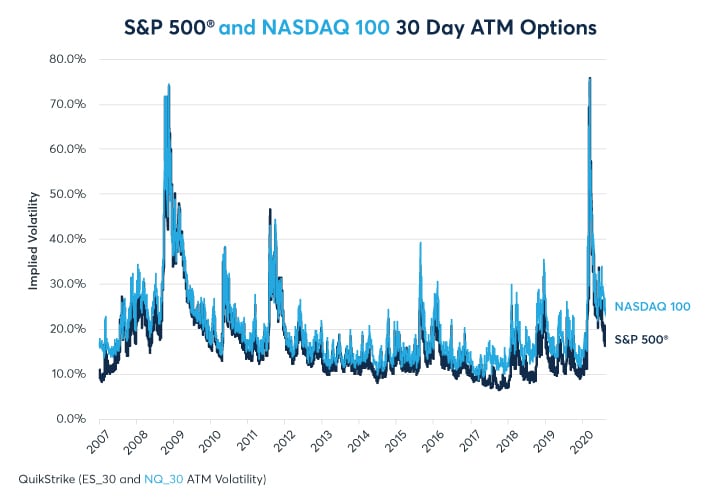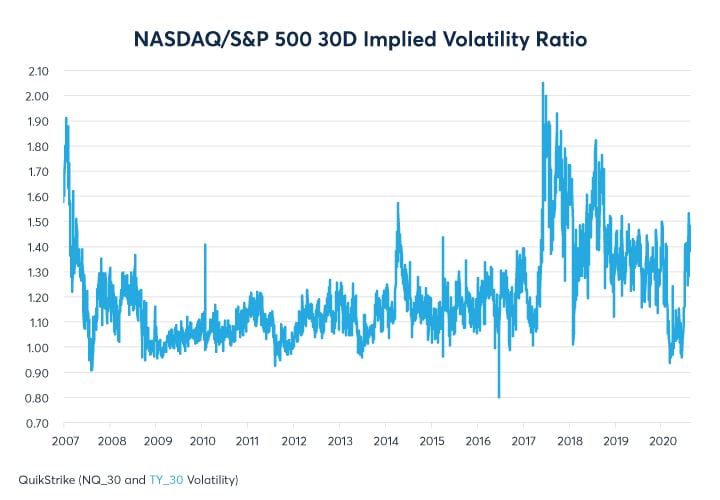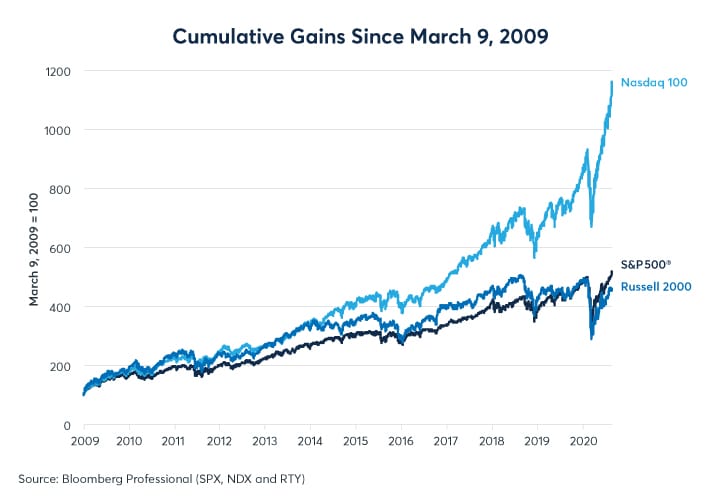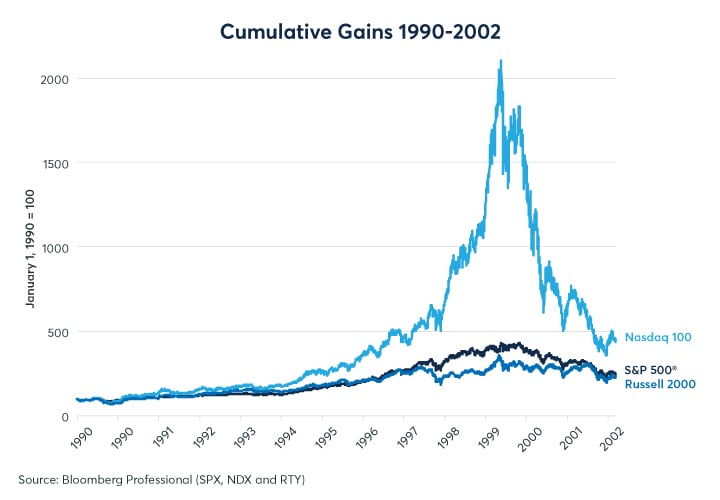NASDAQ 100-S&P 500 Volatility Ratio At Peak Levels
For most of the past decade, option protection on the NASDAQ 100 and S&P 500® cost about the same. From 2017, however, the cost of NASDAQ 100 options began to increase relative to the S&P 500. As of late August, a 30-day at-the-money (30D ATM) option on the NASDAQ 100 traded at an implied volatility of close to 24%, about 50% higher than similar options on the S&P 500 (Figure 1).
Figure 1: NASDAQ 100 options have begun to diverge from S&P 500 options
The ratio between implied volatility on NASDAQ 100 options and S&P 500 options has been volatile over time. Since 2007, the cost of NASDAQ 100 options has averaged 1.2x as much as those on the S&P 500. From 2008 to early 2017, the ratio was around 1.0 most of the time, meaning that the cost of options protection on both indices was usually about the same. Only 5% of the time since early 2007 had the ratio of the cost between the two indices been as high as the 1.5x seen for much of 2020 (although it exceeded current levels during certain periods in 2017 and 2018 (Figure 2).
Figure 2: Only on 5% of days has the NASDAQ 100/S&P 500 implied volatility ratio been higher
The high cost of protection on the NASDAQ 100 relative to the S&P 500 reflects the degree to which the NASDAQ has outperformed in the past few years, and especially since the market’s low point in late March. Since the current bull run began on March 9, 2009, NASDAQ 100 has been the leader, rising more than 1,000% from its post-financial crisis lows. By contrast, the S&P 500 and the Russell 2000 have risen by 410% and 350%, respectively (Figure 3).
Figure 3: The NASDAQ’s outperformance is mainly a post-2014 phenomena
The bull market can be divided into two segments. From 2009 to early 2014, all three indices turned in a similar performance. Most of the divergence has occurred since the beginning of 2015. And that may be a cause for concern among some investors in the NASDAQ 100. The Gen Xers and baby boomers among them might remember that this isn’t the first time that the NASDAQ 100 has outperformed in a similar manner.
During the first half of the 1990s, the NASDAQ 100 turned in a performance analogous to the other two indices only to massively outperform during the second half of the decade, rising over 2,000% from its lows during the 1990-91 recession, while the S&P 500 and the Russell 2000 rose 340% and 240%, respectively. What may be on investors’ minds is what happened next: Between January 2000 and the end of 2002, the NASDAQ 100 fell 85% (Figure 4).
Figure 4: During the second half of the 1990s, the NASDAQ 100 outperformed before retreating
In addition to the NASDAQ’s outperformance, there are several other analogies that one can draw between the current circumstances and the late 1990s:
- Valuation ratios are high, especially for the NASDAQ 100
- In the 1990s and 2010s, technology stocks dominated the rally
- Equities are rallying even as credit spreads widen
- Equities are rallying even as volatility exhibits a pattern of higher highs and higher lows
Valuation measures
Currently, the NASDAQ 100 trades at 67x trailing earnings, close to where it was at its peak in 2000. It trades at 40x estimated earnings in one year’s time and 30x estimated earnings in two years. Even if those earnings projections materialize (and, on average, analysts significantly overestimate future earnings), the NASDAQ 100 looks expensive. The S&P 500 isn’t as pricy (27x trailing earnings, 27x next year’s earnings and 21x estimated earnings in two years). But even the S&P 500 is trading near peak earnings ratios from 2000.
There is one major difference separating 2000 from 2020. While the valuation ratios of the major indices are similarly high, the level of long-term interest rates is much lower. Back then, 30-year Treasury yields, which are often used to discount future earnings into present value, traded between 6% and 7%. Since the equity market’s lows of March, 30Y yields have rarely ventured much above 1.5%. As such, one could argue that despite high price earnings ratios, equities are in fact inexpensive compared to bonds.
At 40x earnings one-year ahead, the NASDAQ 100 has an earning yield of 2.5%, considerably higher than the 1.5% available on 30Y Treasuries. Moreover, this is in sharp contrast to 2000 when the NASDAQ 100’s earnings yield was about one quarter the yield of long-dated government bonds. As such, there is no guarantee that the current level of equity valuation will produce the kind of results for equities that occurred in the decade after Y2K, which was an exceptionally bad one for the equity market.
What Sector Performance Tells Us About Investor Perceptions of Market Risk
A large part of the reason why the NASDAQ 100 outperformed the other indices to such a great extent in the second half of the 1990s and 2010s (and so far in 2020) is that equity market rallies that began as broad-based, a-rising-tide-lifts-all-boats affairs, grew increasingly narrow as they aged. It is striking the extent to which the sectors that dominated equity returns in the 1990s dominated again in the 2010s, and the extent to which they have dominated thus far in 2020. In all three cases, information technology stocks, which dominate the NASDAQ 100, lead the way, followed by consumer discretionary and health care stocks. In the 1990s, 2010s and so far in 2020, energy and materials stocks have underperformed (Figures 5, 6 and 7).
Figure 5: Tech stocks lead the 1990s with health care and consumer discretionary stocks
Figure 6: Tech stocks lead the 2010s with health care and consumer discretionary stocks
Figure 7: Tech stocks have led the way so far in 2020 as well
There are some differences: telecommunications sector stocks did well in the 1990s but underperformed in the 2010s, only to become a hot item again as the pandemic renewed interest in broadband. Financial stocks did quite well in the 1990s but have struggled in the aftermath of the global financial crisis.
What does this have to do with the relative cost of options on the NASDAQ 100 versus the S&P 500? The answer lies in the experience of the intervening decade, from 2000 to 2009. During that decade, the market leaders of the 1990s became the laggards and many of the laggards of the 1990s became leaders (Figure 8). While 2020, so far, has looked like an extension of the 2010s with the pandemic benefitting technology firms and hurting energy companies, there is no guarantee that the remaining 112 months of the 2020s will look anything like the decade’s first eight months.
Figure 8: The underperformers of the 1990s became outperformers in the 2000s and vice versa
The fact that technology shares were hit so hard during the 2000s may be on the minds of investors who are willing to pay 50% more for options on the NASDAQ 100 than for the S&P 500. Indeed, it is striking how underperformers and outperformers changed places from decade to decade. This was true from the 1990s to the 2000s (Figure 8) and again from the 2000s to the 2010s (Figure 9).
Figure 9: Sector outperformers and underperformers switched places from the 2000s to the 2010s.
There are critical differences this time, too. Many of the 1990s technology leaders lacked revenue and didn’t turn a profit. Today, the large technology firms that dominate the NASDAQ 100 have extremely strong revenue and profits. Even so, no company is worth an infinite amount of money and even the most dominant companies could potentially suffer if the ecosystem, or economy, in which they operate does not thrive. Finally, many of the tech leaders in the NASDAQ 100 have come under increased scrutiny in recent years for their market dominance which has led to calls for greater regulation. These factors may also help to explain why investors are willing to pay more for protection on the NASDAQ 100 than on other indices.
Finally, during the late 1990s and again today, stocks are not only rising in an increasingly concentrated manner, they are also rising during a time of expanded credit spreads and rising implied volatility. Credit spreads and volatility are, of course, way down from their highs in March, but what is notable is that even with stocks near record highs and the Federal Reserve buying corporate bonds for the first time, credit spreads are far wider now than they were for most of 2017-19. Likewise, volatility indices are also significantly above previous lows, even with equity indices pushing to new highs.
Patterns of higher lows in both credit spreads pre-dated equity market peaks in the 1990s and 2007 (Figures 10-13). The fact that a pattern of higher lows is the emerging in both credit spreads and volatility indices again (Figure 14 and 15) may also be contributing to the nervousness of investors in the technology firms that are so heavily present in the NASDAQ 100 index.
Figure 10: A pattern of widening credit spreads began three years before the peak in 2000
Figure 11: Volatility began to rise in 1996 and 1997, well before the equity market peak in 2000
Figure 12: Credit spreads began widening eight months before the 2007 equity peak
Figure 13: Volatility began to rise about one year before the 2007-peak
Figure 14: Even Fed buying of corporate bonds has not returned credit spreads to previous lows
Figure 15: Volatility began rising in 2018 and has not returned to previous lows
Bottom Line
- NASDAQ 100 options have decoupled from S&P 500 options.
- NASDAQ 100 has led the equity indices higher, much as it did during the 1990s.
- The advance in tech shares may be leading to increased demand for NASDAQ options.
- Memories of the “tech wreck” may also be contributing to premium in NASDAQ 100 options
- Credit spreads, volatility have not returned to previous lows even as stocks have gone on to new highs
To learn more about futures and options, go to Benzinga’s futures and options education resource.
 Index Options
Index Options CME Group
CME Group Nasdaq
Nasdaq Cboe
Cboe TradingView
TradingView Wall Street Journal
Wall Street Journal













